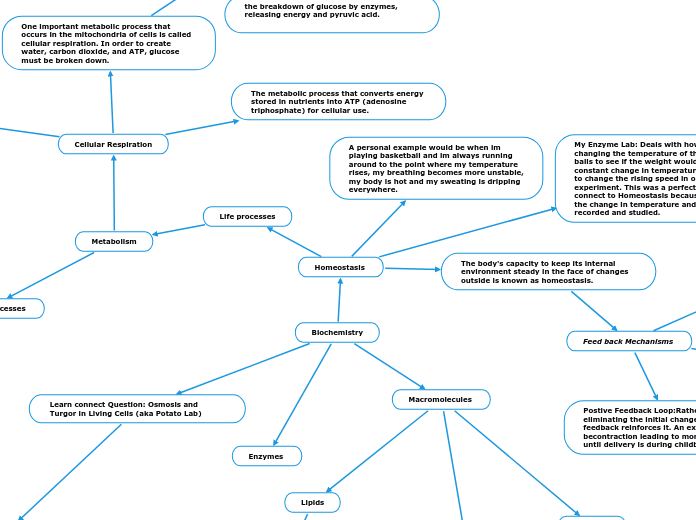Biochemistry
Macromolecules
Proteins
Lipids
Lipids are a diverse group of macromolecules that are hydrophobic (insoluble in water)
Steroids
Steroids are used in society a lot. Used to enhance athletes to improve their performance but it slowly harms the body with many different effects.
asthma
Steroids help calm down inflammation in the lungs to help control asthma.
eczema
With the proper prescriptions from doctors can help heal the eczema with steroid cream. Not as dangerous to use because it's medically prescribed but it's still not healthy to continuously use over time.
Carbohydrates
Homeostasis
The body's capacity to keep its internal environment steady in the face of changes outside is known as homeostasis.
Feed back Mechanisms
Postive Feedback Loop:Rather than eliminating the initial change, positive feedback reinforces it. An example would becontraction leading to more contractions until delivery is during childbirth.
Negative Feedback Loops: main process in homeostasis, whereby the body reacts to a stimulus by balancing. if body temperature rises, mechanisms are triggered to cool it down.
Diabetes
is a disease caused by a broken feedback loop involving the hormone insulin. The broken feedback loop makes it difficult or impossible for the body to bring high blood sugar down to a healthy level.
Life processes
Metabolism
metabolic processes
chemical reactions that occur within living organisms to maintain life. These processes are essential for obtaining energy, building and repairing cellular structures, and regulating various physiological activities
Diabetes
Metabolism plays a very important role in diabetes, influencing how the body produces, uses, and controls insulin, a key hormone involved in glucose homeostasis.
One major societal issue was the expensive for treating diabetes is increasing. Health care is increasing for diabetes all over the world and is causing problems for people who can't afford it.
Cellular Respiration
One important metabolic process that occurs in the mitochondria of cells is called cellular respiration. In order to create water, carbon dioxide, and ATP, glucose must be broken down.
Glycolysis
Krebs Cycle
pyruvate molecules enter the mitochondria, where they undergo the Krebs cycle. The cycle completes the breakdown of glucose, releasing carbon dioxide and producing additional ATP, NADH, and FADH2.
Electron Transport Chain
a group of protein structures found inside the inner membrane of the mitochondria. The Krebs cycle and the production of NADH and FADH2 provide electrons to the chain, resulting in the creation of a proton gradient.
Goes back to the assigment I did in class how about the story I made about how electrons travel through the body.
Photosynthesis
the breakdown of glucose by enzymes, releasing energy and pyruvic acid.
The metabolic process that converts energy stored in nutrients into ATP (adenosine triphosphate) for cellular use.
Energy Production
Energy Balance
Learn connect Questions
Metabolism is really important to polar bears because it has an impact on their survival and energy balance. I made this connection because polar bears have reliance on fat-rich seals that are found in sea ice environments, and their carnivorous diet is the reason for the metabolic rates being high. I connected this to energy balance because in the spring and summer they have to store body fat to withstand the winter.
My Enzyme Lab: Deals with how I was changing the temperature of the enzyme balls to see if the weight would change. The constant change in temperature was proven to change the rising speed in our lab experiment. This was a perfect lab to connect to Homeostasis because it involved the change in temperature and was recorded and studied.
A personal example would be when im playing basketball and im always running around to the point where my temperature rises, my breathing becomes more unstable, my body is hot and my sweating is dripping everywhere.
Enzymes
Learn connect Question: Osmosis and Turgor in Living Cells (aka Potato Lab)
Osmosis and turgor pressure in living cells are concepts that connect to biochemistry, particularly in the context of cell structure, function, and the movement of water and solutes across biological membranes.
This lab taught me a lot about how sugar solutions operated in water and many different variables could affect the change in the results. It was proven by me that if the sugar solution in our test tubes were to be changed then our potato data would be different because there's an influence that's inconsistent in our experiment.
